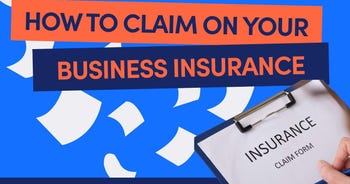A small business guide to underinsurance and how to prevent It
In 2023, Aviva estimated that 50% of SMEs were underinsured 1 - that's half of all UK small businesses. Why so high? Estimating the value of your business assets and understanding what policies you need can be difficult to navigate on your own. Especially when all you want to do is to ensure your company is properly covered.
But what happens when you get it wrong and your package doesn’t cover all of the assets you own? Well, that’s called underinsurance.
Whether intentional or not, underinsurance can lead to bad consequences if you make a claim or a claim is made against you and you're not properly covered, and it can leave you out of pocket. Learn more about underinsurance to make sure you're not at risk with this Bionic guide.

What is underinsurance?
Simply put, underinsurance means the level of insurance you have isn’t enough. This would leave you, as the policyholder, responsible for a larger percentage of the total loss if a claim was made for or against you, and you could end up paying more to cover the costs. It could also potentially mean the insurance policy could be cancelled/voided, especially if there is a significant amount of underinsurance.
Whether a fire damages your business or someone is injured on your premises, an insurance policy should cover most of the costs, so that you only pay an excess.
What’s the difference between being underinsured and uninsured?
Underinsured and uninsured can often be confused for the same thing since they’re spelt almost the same - but there’s a big difference between the two.
We know that underinsured means you don’t have the right level of insurance to cover the value of the item(s) you’re insuring.
On the other hand, being uninsured means you don’t have any insurance in place whatsoever.
To make sure that your business is covered should the worst happen, speak to our knowledgeable insurance team to find the right business insurance package for you.
What causes underinsurance?
Let’s shed some light on some of the most common reasons underinsurance can (unintentionally) catch you off guard:
- Incorrectly estimating the amount of cover your business needs — When you run a small business, it can feel like you’ve got your fingers in multiple pies just trying to make sure everything is running smoothly. Also, estimating the amount of cover your business needs without a thorough assessment can lead to you being underinsured. It’s essential that you do a bit of housekeeping — or potentially hire a professional valuator if you’re not sure — to ensure that your insurance coverage matches your business's actual needs.
- Not factoring in inflation into the value of your assets and costs — Imagine if your favourite chocolate bar costs the same as it did ten years ago. It’s a nice thought, but not in line with the times. Just like the cost of living has increased, so has the cost of inflation. In fact, in 2014, inflation was at 2.4%, rising to a staggering 9.7% in 2023. Not factoring in inflation can mean the amount you’re currently insured for might not cover the full cost of replacing or repairing your assets today.
- Selecting the wrong level of insurance cover — We know that it can seem tempting to go for a basic option because it’s cheaper, but this doesn’t always mean it’s the best. Selecting the wrong level of insurance — potentially because it’s a cost-saving option — can cost you more in the long run if it doesn’t fully meet your business needs. At Bionic we focus on getting small businesses the right business insurance cover, so you’re not left to pick up the pieces should the worst happen.
How to work out if you’re underinsured
Knowing whether you’re underinsured can sometimes be a bit of a challenge, especially if you're just starting out. Here are some tips and tricks to help to understand whether you have the right insurance:
Work out the value of your business and assets
At the top of your to-do list, you’ll need to take a deep dive into understanding what your business and its assets are truly worth. This isn’t just about how much you’ve invested or what the sheets are saying - you’ll need to assess the replacement costs of your assets, including:
- Property
- Equipment
- Intangible assets (non physical things)
The idea is to note down every part of your business that adds value - from your cash registers to all the stock in your warehouse. It’s best to do this every few years so you get a fresh view of your business's value.
Need some more guidance? Learn how to determine the value of your small business.
Review your value against your current policy
Now that you have your new estimations to hand, you’ll want to compare this against your current insurance policy.
Imagine you just revalued all your business assets at £30,000, but your last valuation was £15,000 a few years ago, and your business insurance policies are based this outadated business valuation. Then technically - you’re 50% underinsured.
If you find there’s a mismatch like above, it’s the right time to contact your insurer and broker to adjust your existing policies or compare business insurance to make sure you’re properly covered.
Check your policy limits
Policies come with limits, and as with all insurance options, you might find that you need a more comprehensive policy as your business grows. For example, your cafe might have a new kitchen fitted with deep fat fryers - these pose more of a risk and therefore need to be considered when it comes to your cafe insurance package.
It’s best to dive into the fine print of your policies and check the limits on each type of cover. Are they enough to fully replace or repair your assets at today’s prices? Remember, it’s not just about the total cover offered but also about the specific limits that might apply to different parts of your business.
Contact your insurance provider to up your limits
If you’re happy with your policy, then it might just be a case of tweaking your existing insurance to adjust your limits to what best suits your business as it grows!
And if you’re looking for another insurance option, give them a call, as they’ll be able to help find cover that better matches your current needs.
What effects can underinsurance have on businesses?
It might not seem like a big deal when your business is staying afloat, but if you make one wrong move, you could find yourself in a tight spot. Here are some of the issues you may run into if you’re uninsured:
- Not receiving enough compensation when you make a claim — If your business is underinsured and you need to make a claim, the compensation you receive might not fully cover the extent of the losses. This means instead of getting your business back up and running the way it was before the incident - you might only make it halfway there. It’s key that the level of cover you have fully covers all the risks that come with running your business, so you have the right support in place should you need it.
- Having to cover the rest of an insurance claim yourself — When the compensation doesn’t cover the full damage or loss, guess who has to cover the rest? That’s right, it’s your business. This could mean that you are left out of pocket as you try to bridge the gap left by underinsurance. It’s not only stressful, but it diverts much-needed resources away from where you need it most — growing your business.
- Having your policy voided — In some cases, being badly underinsured can lead to insurers considering the policy void. If it turns out that you’ve significantly underestimated the value of your insured items or misrepresented your business — whether intentional or not — insurers will see this as a breach of policy terms. This could leave you without the proper cover just when you need it most, not to mention the potential legal and financial repercussions on your business that could follow.
Which areas are known to be at risk of underinsurance?
It’s hard to say for certain which areas of insurance are most at risk of underinsurance - but, some of the most common include:
Business interruption
Business interruption insurance aims to protect you and your business if a disaster event means you’re not able to operate normally. But, it’s easy to underestimate how long your business might need to recover from an event like a natural disaster or a global pandemic.
If the cover isn’t enough, you might find your business in a muddle if something goes wrong and it carries on longer than you’ve anticipated. You might find yourself struggling to cover ongoing expenses without your usual income.
Business property
This type of commercial property insurance covers the physical assets of your business, from the building it occupies to the furniture inside.
The risk of underinsurance arises when the replacement costs for these assets exceed the insured value — this is usually due to the policy not being updated to reflect things like renovations, expansions or increases in property value.
Equipment
Whether it’s your team’s laptops, the kitchen in your restaurant you use to cook up a storm, or the specialised machinery keeping your factory up and running, equipment is the backbone of your operation.
If you’re underinsured, it might mean that you’re not able to replace or repair vital equipment quickly or fully after a loss, potentially leaving your business struggling along with a patchwork of temporary solutions.
Cyber
As cyber threats evolve and expand, the cover you initially set up might no longer fully protect against the risk of potential damages — from data breaches to ransomware attacks.
In fact, over 560,000 new cyber threats are discovered daily, and 81% of UK businesses that suffer from an attack are SMEs.
Underestimating the financial impact of an event of this magnitude can leave your business exposed to out-of-pocket costs for recovery, legal fees and even more.
Learn more about cyber insurance in our guide.
Tips for avoiding being underinsured
The complexities of business insurance can be daunting, especially for SMEs. Making sure your company has the right level of cover is crucial to safeguarding your operations, employees and assets from any unforeseen events. Here are some of our best tips to help you steer clear of being uninsured:
Keep a regular and up-to-date stock inventory
Your stock is the livelihood of your business, and its value can change a lot over time. Regularly checking and updating your inventory records helps make sure that your insurance cover reflects the current value of your stock. It also helps to streamline your stock management and helps aid in accurate insurance claims.
Review rebuilding costs regularly
The cost of repairing or rebuilding your premises can vary depending on things like:
- Material costs
- Labour rates
- Building regulations
- Location – costs vary depending on where the building is located.
Annually reviewing these costs means you’ll have the right level of insurance cover, and you won’t be left out of pocket covering the rebuilding expenses yourself.
Access the indemnity period of your policy
The indemnity period refers to the timeframe within which the insurance company will cover your business losses following making a claim.
It’s so important that you carefully assess this period to ensure it aligns with the realistic timeframe your business would need to recover from a major loss or disruption.
Factor in new purchases
As your business grows, naturally, so do your assets. New equipment, technology or even simple things like your office furniture can significantly increase the total value of your business assets.
Regularly updating your policy to include these new purchases ensures that they are covered from the get-go.
Get a policy tailored to your specific industry
No two businesses are alike, and whether you’re running a little cafe on the high street or you’re on the move with your mobile salon, you’re going to need a policy that’s tailored to your specific business needs.
Specifically, tailored policies offer coverage that’s more in line with your business's unique risks and requirements. Take tradies, for example, will need cover for tools and machinery as well as cover for apprentices on site. On the other hand, if you run a takeaway, you won’t need cover for apprentices, but you’ll need a takeaway insurance package, that covers everything from the risks of food poisoning to fires caused by fat fryers.
Get your business insurance right with Bionic
Underinsurance can set your business off on the wrong foot. At the end of the day, you want to make sure that you have the policies in place so that if the worst should happen, you’re totally covered, and you won’t have to pay any hefty fees, apart from a small excess.
At Bionic, our dedicated insurance team is on hand to help you find the right cover for your business - start a quote online today.
Or, head over to our business insurance guides page for everything you need to know about insurance for your business and then some!
1 Figures relate to Aviva's Risk Insights Report published in January, 2023








